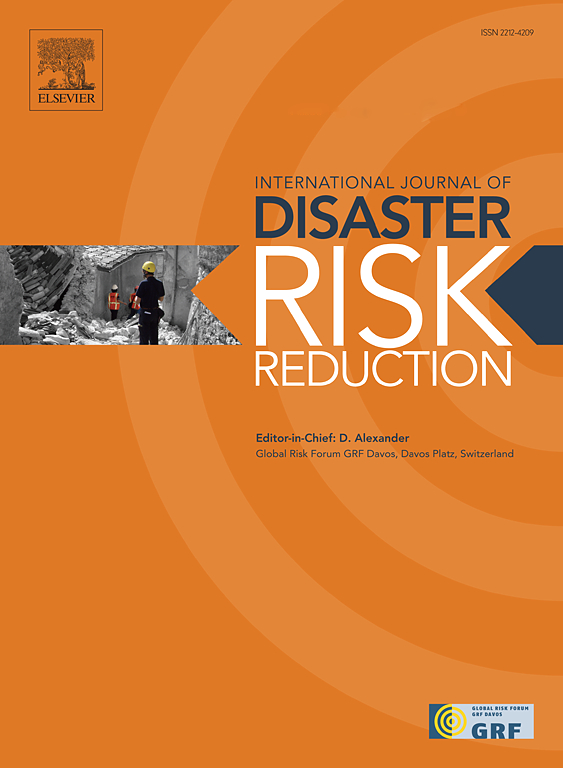GeoLCES: Geospatial support for evaluating wildland firefighter lookouts, communications, escape routes, and safety zones
IF 4.5
1区 地球科学
Q1 GEOSCIENCES, MULTIDISCIPLINARY
International journal of disaster risk reduction
Pub Date : 2025-07-17
DOI:10.1016/j.ijdrr.2025.105714
引用次数: 0
Abstract
Wildland firefighters play a critical role in managing the complex relationship between humans and fire. To reduce the inherent risks that come with this role, firefighters use safety protocols such as lookouts, communications, escape routes, and safety zones (LCES). Currently, LCES implementation is conducted on the ground with limited support from geospatial information, despite the protocol's inherently spatial nature. This study introduces GeoLCES: an analytical framework designed to enhance LCES implementation using remote sensing and geospatial modeling. GeoLCES comprises three spatially explicit safety metrics, derived from airborne lidar data: (1) visibility index (VI), which quantifies landscape-wide visibility, aiding the evaluation of lookouts and communications; (2) escape route index (ERI), which quantifies mobility, facilitating the identification of escape routes and avoidance of entrapment-prone area; and (3) proportional safe separation distance (pSSD), which quantifies the relative degree of sufficient fuel separation, enabling the identification of suitable safety zones. In this study, we describe the theory, computation, application, and interpretation of each of these three metrics as a multivariate, pre-fire decision support tool. To highlight implementation on a useful scale, we map GeoLCES at 30m resolution throughout Gila National Forest in New Mexico, USA. We provide an operationally relevant use-case demonstration to exemplify one approach for employing GeoLCES at the incident level. GeoLCES is the first geospatial analytical framework that seeks to specifically address the complex, multivariate nature of LCES in a holistic manner, and has the potential to improve wildland firefighter safety at a time of increasing fire management demands.
geoces:用于评估荒地消防员瞭望、通信、逃生路线和安全区的地理空间支持
野外消防员在处理人类与火灾之间的复杂关系方面发挥着关键作用。为了减少这一角色带来的固有风险,消防员使用了诸如监视、通信、逃生路线和安全区(LCES)等安全协议。目前,尽管协议具有固有的空间性质,但LCES的实施是在地面上进行的,地理空间信息的支持有限。本研究介绍了geoces:一个旨在利用遥感和地理空间建模来增强LCES实施的分析框架。GeoLCES包括三个空间明确的安全指标,源自机载激光雷达数据:(1)可见性指数(VI),量化景观范围内的可见性,帮助评估瞭望塔和通信;(2)逃生路线指数(ERI),量化机动性,有助于识别逃生路线和避免容易被困的区域;(3)比例安全分离距离(pSSD),量化燃料充分分离的相对程度,从而确定合适的安全区域。在本研究中,我们描述了这三个指标的理论、计算、应用和解释,作为一个多变量的事前决策支持工具。为了突出在有用尺度上的实施,我们在美国新墨西哥州的吉拉国家森林以30米分辨率绘制了GeoLCES地图。我们提供了一个与操作相关的用例演示,以举例说明在事件级别使用GeoLCES的一种方法。GeoLCES是第一个地理空间分析框架,旨在以整体方式专门解决LCES的复杂性和多变量性质,并有可能在不断增加的火灾管理需求中提高荒地消防员的安全。
本文章由计算机程序翻译,如有差异,请以英文原文为准。
求助全文
约1分钟内获得全文
求助全文
来源期刊

International journal of disaster risk reduction
GEOSCIENCES, MULTIDISCIPLINARYMETEOROLOGY-METEOROLOGY & ATMOSPHERIC SCIENCES
CiteScore
8.70
自引率
18.00%
发文量
688
审稿时长
79 days
期刊介绍:
The International Journal of Disaster Risk Reduction (IJDRR) is the journal for researchers, policymakers and practitioners across diverse disciplines: earth sciences and their implications; environmental sciences; engineering; urban studies; geography; and the social sciences. IJDRR publishes fundamental and applied research, critical reviews, policy papers and case studies with a particular focus on multi-disciplinary research that aims to reduce the impact of natural, technological, social and intentional disasters. IJDRR stimulates exchange of ideas and knowledge transfer on disaster research, mitigation, adaptation, prevention and risk reduction at all geographical scales: local, national and international.
Key topics:-
-multifaceted disaster and cascading disasters
-the development of disaster risk reduction strategies and techniques
-discussion and development of effective warning and educational systems for risk management at all levels
-disasters associated with climate change
-vulnerability analysis and vulnerability trends
-emerging risks
-resilience against disasters.
The journal particularly encourages papers that approach risk from a multi-disciplinary perspective.
 求助内容:
求助内容: 应助结果提醒方式:
应助结果提醒方式:


